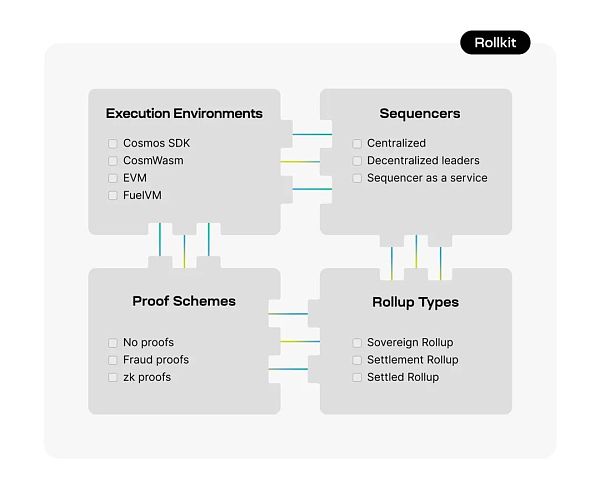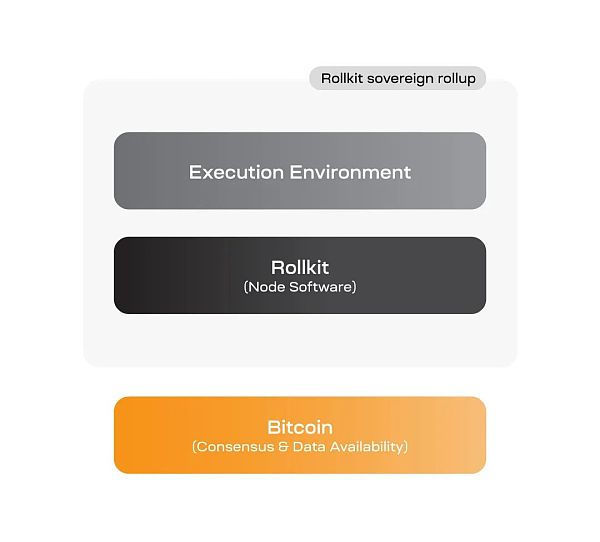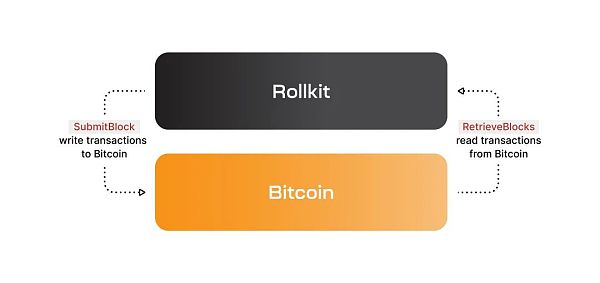The first Bitcoin Sovereign Rollup project Rollkit.
The first Bitcoin Sovereign Rollup project, Rollkit.Rollkit is a modular Rollup framework that allows developers to deploy Rollup freely throughout the modular stack, including Sovereign Rollup and Settlement Rollup. In March of this year, Rollkit, a modular Rollup framework product under the modular blockchain Celestia, announced support for Bitcoin Sovereign Rollup, allowing Rollkit Rollups to use Bitcoin’s data availability.
This report will explain in detail what problems the first modular framework Rollkit that supports Bitcoin Sovereign Rollup solves, and how it uses Bitcoin to provide data availability.
1. Project Introduction
Rollkit is a modular development chain SDK developed by the Celestia community. It is a Rollup framework that allows developers to deploy Rollup throughout the modular stack and easily modify it to suit their applications, opening up new possibilities for rapid experimentation and innovation.
- The New Narrative of Cryptocurrency Investment in a Bear Market Unibot Project Analysis
- Cosmos ecosystem’s living water Entangle and Tenet, the dual heroes of the whole chain LSD.
- Reddit Avatar One-Year Anniversary Layout and Insights Behind the NFT Project with the Largest User Scale
The Rollkit framework has a modular node that can run Rollup and expose an ABCI-compatible client interface, which can be used as an alternative to Tendermint in any ABCI-compatible blockchain application. By default, the node uses Celestia as the Data Availability (DA) layer, but other data availability layers can be integrated.
Rollkit was developed in 2021 and has now become an independent product separate from the Celestia blockchain. Rollkit will serve as a community-driven public product to drive the development of the modular ecosystem. Currently, Rollkit can be used to deploy Sovereign Rollup or Sovereign settlement layers.
2. Project Vision
Deploying decentralized applications as smart contracts on a shared blockchain means that it shares computational resources and is limited to the execution environment of that blockchain. This limits the scalability and flexibility of the application. On the other hand, if a new L1 public chain is deployed, developers must gather a set of validators to secure the chain, issue tokens to compensate these validators, and continuously maintain network infrastructure. This means huge costs in terms of social coordination, time, capital, and expertise, which hinder many developers from launching their own blockchains. The emergence of Rollkit solves the challenges encountered when deploying smart contracts or new L1. Rollup provides similar advantages to L1 blockchains but reduces the cost of deploying and maintaining their own chains.

The goal of Rollkit is to enable developers to create new Rollups quickly and at minimal cost, making deploying new chains as simple as deploying smart contracts. It provides developers with a variety of choices so that they can easily insert, switch, or replace functionalities in Rollkit. The customizable stack of Rollkit will allow developers to bring their products to market faster and more flexibly.
3. Development History
Celestia Labs started developing Rollkit in 2021, when the modular ecosystem was still in its infancy and there was no general Rollup software. Celestia Labs began building Rollkit out of its own needs because having general software for Rollup chains was crucial to Celestia’s mission, as at that time Celestia Labs aimed to make deploying new chains as simple as deploying smart contracts.
In February 2023, Rollkit was separated from Celestia Labs and became its own project, with its own GitHub organization and documentation website, becoming a community-driven public project. The separation of Rollkit will allow Celestia and Rollkit to serve the entire modular ecosystem as public products, with these public products being neutral and independent of each other in the modular stack, ensuring that Celestia is a decentralized and trusted neutral data availability layer.
In March 2023, Rollkit announced support for Bitcoin Sovereign Rollup, allowing Rollkit Rollup to use Bitcoin’s data availability. Developers can create Rollups with arbitrary execution environments, inheriting Bitcoin’s data availability and security guarantees. Through this integration, the EVM can be run on Bitcoin as a Rollkit Sovereign Rollup.
Currently, Rollkit is still in the MVP stage. The framework currently provides an execution interface (ABCI or Cosmos SDK) and a connection to the data availability layer (Celestia). Developers can use Rollkit to build on Celestia’s Mocha testnet.
IV. Project Architecture
Application Structure
ABCI Interface
Rollkit is a feature-complete application blockchain interface (ABCI) client software. It allows developers to switch between different runtime environments and can be used as a CometBFT alternative for any ABCI application. Due to this compatibility, users can use tools like abci-cli to test and debug Rollups.
Data Availability
The general ABCI interface can be used to access the Data Availability layer (DA), allowing seamless integration with any DA layer. New implementations can be inserted programmatically without forking Rollkit. Celestia is an example of data availability integration implemented for Rollkit. By integrating with data, Rollkit Rollup can be deployed on Celestia. In addition, Rollkit also supports the use of other Data Availability (DA) layers. Currently, Rollkit Rollup supports the use of Bitcoin’s data availability.
Node Types
Full Nodes
Full nodes validate all blocks and generate fraud proofs for OP Rollup. Since they fully validate all Rollup blocks, they do not rely on fraud or validity proofs to ensure security.
Light Nodes
Light nodes are lightweight Rollup nodes that validate block headers and can protect against fraud proofs or validity proofs. Users running light nodes can perform trust-minimized queries on the Rollup state. Currently, Rollkit light nodes are still under development.
Sequencer Nodes
Rollup can leverage sequencer nodes. Sequencers are block producers for Rollup, responsible for aggregating transactions into blocks and typically executing transactions to generate a state root for use by Rollup’s light clients.
Rollkit plans to support various pluggable sequencer schemes:
| One-click Deployment | Faster confirmation than L1 | Control over Rollup transaction order | Atomic composability with other Rollups | Censorship resistance | Status | |
| Centralized Sequencer | Requires starting a sequencer | Yes | Yes | No | Final stage | Implemented |
| Decentralized Sequencer | Requires starting a sequencer | Yes | Yes | No | Real-time | Planned |
| Shared Pool of Sequencers | Yes | Yes | No | Yes | Real-time | Planned |
| Pure Fork Selection Rules | Yes | No | Uncertain | Uncertain | Final stage | Planned |
Note: “Pure Fork Selection Rule” refers to any Rollup without a privileged sequencer, for example, nodes follow the data availability layer for ordering and apply a “first-come, first-served” fork selection rule.
5. Team & Financing
Celestia Labs initially started developing Rollkit in 2021, and now Rollkit has become an independent project. After being separated, Rollkit has become a community-driven public product, and the community collaboratively promotes the development of the ecosystem and holds regular conference calls. Currently, according to GitHub, there are more than 30 active contributors, mainly from Celestia Labs’ solution engineers and other blockchain developers and software engineers.
In addition, GitHub data shows that the project has maintained a high level of code commits, especially since announcing support for Bitcoin Sovereign Rollup in March. The consistent level of code commits indicates that the project has been making continuous progress.

6. Achievements
In March 2023, Rollkit announced itself as the first Rollup framework to support Bitcoin, enabling data availability through Rollkit Rollups using Bitcoin. Developers can create Rollups with arbitrary execution environments, inheriting Bitcoin’s data availability and security guarantees. Through this new integration, it is possible to run EVM on Bitcoin as a Sovereign Rollup using Rollkit.
Rollkit states that based on Bitcoin’s Taproot upgrade and Ordinals, it becomes possible to use Bitcoin to achieve data availability in Sovereign Rollup.
SegWit introduced the concept of witness data by removing part of the witness data from transactions, reducing the block size occupied by each transaction. Taproot improves on the SegWit upgrade by eliminating the size limit on witness data. By using Taproot scripts in witness data, it becomes possible to store arbitrary data of size 4MB. With the two upgrades of SegWit and Taproot, a large amount of data can be published on the Bitcoin blockchain network. Since then, Sovereign Rollup and dapp ecosystems on Bitcoin may become a reality, while at that time, there was a lack of Rollup frameworks that could easily integrate Bitcoin as a data availability layer.
Rollkit, as a modular framework for Rollup, allows developers to insert custom execution layers and data availability layers. Initially, Rollkit only supported Celestia as an option for data availability and consensus. With the early research implementation of Rollkit’s Bitcoin data availability module, Bitcoin became an option in which Sovereign Rollup manages its own execution and settlement while transferring consensus and data availability to Bitcoin.

To read and write data on Bitcoin, Rollkit uses Taproot transactions. To achieve this, a Go package called bitcoin-da (Bitcoin Data Access) has been developed, providing Taproot read and write interfaces for Bitcoin data. This package can be reused by any project that wants to read from or write to Bitcoin data.
The construction of Rollkit is centered around standardization. It has a data availability interface that allows developers to easily implement specific methods to add new data availability layers. To add a data availability layer, implementers need to meet the DataAvailabilityLayerClient interface that defines the behavior of the data availability client, as well as the BlockRetriever interface that defines how blocks are synchronized. These interfaces are located in the data package. The most important functions of these interfaces are SubmitBlock and RetrieveBlock for reading blocks.

From here, Rollkit implements Sovereign Rollup on Bitcoin, which not only expands the possibilities of Rollup, but also may help guide a healthy block space fee market for Bitcoin, enabling more sustainable security allocation.
In addition to integrating the Bitcoin data availability layer, developers are currently also exploring the use of this integration for innovation and replicating it on other L1 blockchains.
7. Economic Model
Currently, Rollkit has not issued tokens.
8. Advantages and Risks
Advantages
-
Scalability: Rollkit Rollup is deployed on a dedicated data availability layer, directly leveraging the scalability of the DA layer. In addition, Rollup transactions are executed off-chain, rather than on the data availability layer. This means that Rollup has its own dedicated computing resources, rather than sharing computing resources with other applications.
-
Customizability: Rollkit allows developers to more easily use the main components and customize their Rollup. These components are the data availability layer, execution environment, proof system, and ordering scheme. The components used in the Rollkit stack are customizable.
-
Faster deployment time: Rollkit eliminates the need to bootstrap a validator set, manage a consensus network, incur high economic costs, and face the challenges of deploying a new L1. Rollkit aims to make deploying Rollup as simple as deploying smart contracts, reducing the time required to bring blockchain products to market from months or even years to minutes.
Risks
-
Controversy of Sovereign Rollup: Sovereign Rollup is still a relatively new field, with its own consensus that can operate independently of a layer one blockchain, define its own transaction validation and settlement rules, and have greater autonomy. However, this independence also to some extent sacrifices the security guarantees of a layer one blockchain, and implementing Sovereign Rollup upgrades can be complex due to the separate consensus mechanism.
-
Lack of effective market validation: The project is still in a very early stage. First, from the perspective of project progress, after integrating the Bitcoin data availability layer in March, the project has not shown any other direction of innovation. Second, in terms of community size, there are 3,800 followers on Twitter and only 211 members in the Telegram group, and whether it will succeed requires further validation from the market, as both Twitter and other communities have very low member activity.
At present, various new types of Rollups continue to emerge, and the development of Rollups has opened up new possibilities for the use of L1 blockchain data availability layers. The true potential of Rollkit lies in its developer and user community. The project is currently open source, and in the future, when Rollkit integrates new data availability layers, its community members will improve this integration and use it in a way that truly benefits the community.
We will continue to update Blocking; if you have any questions or suggestions, please contact us!
Was this article helpful?
93 out of 132 found this helpful
Related articles
- Worldcoin in the Polkadot ecosystem? Another money-spreading project Encointer analysis
- Quick Overview of Recent Popular DeFi Narratives and Innovative Projects
- Inventory of the 8 old projects of the transformation LSD
- Crossing the Bull and Bear The LSD Battle of the Project Party
- Crossing the Bull and Bear The LSD Battle of Project Parties
- A summary of 10 projects worth paying attention to recently DeFi, DEX, games, and on-chain tools
- Full-chain gaming becomes the market focus, in-depth analysis of the pioneering project Dark Forest.






